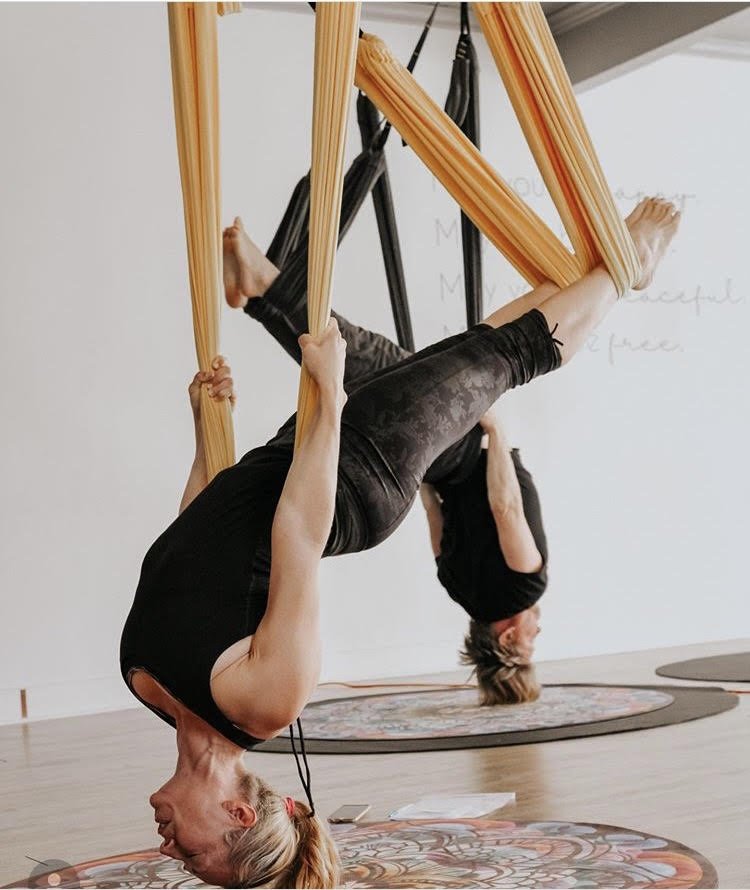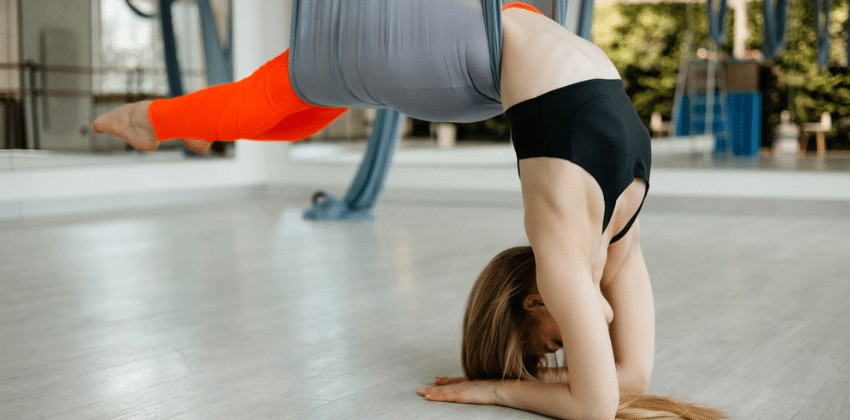A Yoga Trapeze is a swing-like contraption that allows you to practice inversion therapy and aerial yoga. It typically hangs from a support beam, ceiling, or stand for suspended yoga postures and movements.
Exploring the realms of flexibility, strength, and balance, a Yoga Trapeze provides a unique form of exercise and relaxation. It acts as a tool for deepening stretches, challenging traditional yoga poses, and introducing an acrobatic element to your practice. The trapeze includes a sling, handles, and straps to support a variety of exercises targeting the entire body.
Its design caters to a range of movements from gravity-defying inversions to gentle reclining positions. With regular use, users often report improved back strength, enhanced core stability, and reduced spinal compression. Whether you’re a yoga enthusiast or simply seeking a new way to improve your fitness, the Yoga Trapeze offers an engaging and effective workout option.

Credit: www.instagram.com
The Yoga Trapeze Unveiled
Imagine soaring through the air, body suspended in a graceful posture. This is the Yoga Trapeze, a unique blend of traditional yoga and aerial acrobatics. In this post, we’ll explore the thrilling world of Yoga Trapeze, its history, structure, and benefits. Whether you’re a seasoned yogi or just starting, the Yoga Trapeze offers a new way to stretch, strengthen, and invert the body.
Aerial Yoga Roots
Yoga finds new heights with the evolution of aerial yoga. Aerial yoga takes inspiration from circus arts, Pilates, and dance. A Yoga Trapeze enables these moves in a fun, secure way. People of all ages enjoy its benefits. It’s a modern twist on ancient practice.
- Boosts flexibility
- Improves core strength
- Enhances spinal and shoulder health
Anatomy Of A Yoga Trapeze
The Yoga Trapeze is an apparatus that consists of different parts. Below is a breakdown of its core components:
| Component | Description |
|---|---|
| Main sling | The fabric you sit or lie on |
| Handles | Used for grip and balance |
| Support straps | Adjust height and stability |
Durable materials form the Yoga Trapeze. They keep you safe while you explore new poses. The design also allows for quick installation at home or a studio.
Benefits Of Yoga Trapeze Practice
Discover the Yoga Trapeze, an exciting tool that takes your yoga practice to new heights! Imagine merging the benefits of traditional yoga with aerial maneuvers; that’s what a Yoga Trapeze does. It’s a swing-like device that allows you to hang from a stable bar or doorway. This unique form of yoga improves strength, flexibility, and spinal health. Let’s explore how.
Spinal Decompression
Inverting on a Yoga Trapeze takes pressure off your spine. Gravity gently pulls your body, creating space between vertebrae. This effect can relieve back pain and increase circulation.
- Decreases back pain
- Boosts circulation
- Enhances spinal health
Core Strength Enhancement
Engaging your core is essential in Yoga Trapeze. Stabilizing movements work your abdominal muscles deeply. It results in a stronger core and improved posture.
- Deepens core muscles activation
- Promotes a stronger, more resilient core
- Leads to better posture and body alignment
Flexibility And Balance Improvement
Yoga Trapeze poses require and develop flexibility and balance. Regular practice enhances your body’s range of motion and stability. You may notice an improvement in your everyday movement.
| Flexibility | Balance |
|---|---|
| Expands range of motion | Increases stability |
Embrace the exhilarating world of Yoga Trapeze and enjoy these holistic benefits!
Setting Up Your Yoga Trapeze
Embarking on your aerial yoga journey begins with setting up the ideal space for your yoga trapeze. This exciting setup can transform your workouts, but careful attention is necessary to ensure safety and enjoy the full extent of this unique yoga practice.
Choosing The Ideal Location
Finding the right location is crucial to your yoga trapeze experience. Look for a spacious area with high ceilings – typically at least 9 feet high, and free from obstacles. Make sure the location is peaceful and safe to allow complete focus and relaxation.
Consider these points for the perfect spot:
- Sturdy beams or branches for outdoor installations
- An indoor area with durable fixtures for ceiling mounting
- Adequate floor space for movement
- Soft flooring or yoga mats below
Installation Essentials
Proper installation of your yoga trapeze ensures you can practice with confidence. Gather your tools and follow each step meticulously.
You’ll need:
| Tool | Use |
|---|---|
| Stud Finder | Locate ceiling joists |
| Drill | Pre-drill holes |
| Wrench | Tighten bolts |
| Measuring Tape | Confirm correct distance |
Steps for trapeze installation:
- Use a stud finder to locate a secure spot in your ceiling.
- Mark and measure the distance between two points for hooks.
- Pre-drill holes for the ceiling mounts.
- Insert and tighten the bolts to secure mounts.
- Hook the trapeze safely onto the mounts.
- Double-check the setup is firm before first use.
Tip: If unsure, seek help from a professional installer. Always review the yoga trapeze’s manual for detailed instructions and weight specifications.

Credit: www.mettayogastudio.com
Getting Started With Your Practice
Embarking on a yoga trapeze journey marks the start of an exciting adventure for the body and mind. Tailored for those eager to enhance their fitness with inversion therapy and aerial yoga, yoga trapeze stands as a fun, dynamic tool. Understanding the basics, however, is crucial for a safe and effective practice.
Safety Tips For Beginners
Jumping into yoga trapeze necessitates a safety-first approach. Consider the following to ensure you start off on the right foot:
- Secure setup: Install your yoga trapeze on sturdy beams or a reliable stand.
- Inspect equipment: Always check for signs of wear and tear before use.
- Clear space: Provide ample area around your trapeze to avoid obstacles.
- Start slow: Begin with basic movements to build confidence and strength.
- Listen to your body: Avoid pushing into pain or discomfort.
- Seek guidance: Consider a class or tutorials from certified instructors.
Basic Yoga Trapeze Poses
After ensuring safety, it’s time to explore some simple poses. These foundational exercises are designed to adapt your body to aerial movements:
- Inverted Monkey: Hang upside down and swing gently to open your spine.
- Flying Dog: Kneel in the sling and stretch arms forward to release back tension.
- Seated Twist: Sit in the trapeze and rotate your torso for a spinal twist.
- Levitating Lotus: Sit with legs crossed and let gravity lift your spirit.
- Skyward Warrior: Stand with the trapeze supporting your back, reach up, and bend backwards.
Remember to breathe deeply and move with intention in each pose to maximize benefits.
Advanced Techniques And Variations
Yoga trapeze invites practitioners to elevate their practice with advanced techniques and variations. Mastery over foundational moves unlocks a world of challenging poses and sequences. These not only deepen flexibility but also enhance strength and balance. This section delves into sophisticated methods, offering enthusiasts pathways to physical and mental growth.
Inversion Therapy Explained
Inversion therapy involves being upside down to decompress the spine and improve circulation. The yoga trapeze is a perfect tool for such therapies. It allows safe and controlled inversions that help reduce back pain and relieve stress.
- Gravity Boot: Hang by the feet for decompression.
- Full Inversion: Experience complete upside-down suspension.
- Bat Pose: A restorative pose that enhances spine flexibility.
Strength Training On The Trapeze
Integrating strength training within a yoga trapeze routine can boost muscle tone and endurance. Exercises focus on the core, arms, and legs.
| Exercise | Target Area |
|---|---|
| Pull-ups | Arms and Back |
| Knee Tucks | Core |
| Pike Presses | Shoulders |

Credit: www.amazon.com
Frequently Asked Questions Of What Is A Yoga Trapeze
What Is A Yoga Trapeze Used For?
A Yoga Trapeze is used for practicing aerial yoga, which helps to improve flexibility, strength, and balance. It assists with deeper stretches and inversion therapy, promoting spinal health and muscular relief.
How Does A Yoga Trapeze Benefit Your Body?
Using a Yoga Trapeze benefits your body by allowing for gravity-assisted stretches and inversions. This can lead to decompression of the spine, enhanced core strength, and increased overall flexibility.
Can Beginners Use Yoga Trapezes Safely?
Yes, beginners can use Yoga Trapezes safely with proper instruction and by following safety guidelines. Starting with basic poses and gradually progressing is essential for safely enjoying the benefits of aerial yoga.
How Much Space Is Required For A Yoga Trapeze?
To safely use a Yoga Trapeze, you’ll need a clear area with a minimum of about 50 square feet. Ensure a distance of at least 2 feet from walls and ceilings tall enough to accommodate inversions.
Conclusion
Exploring the yoga trapeze offers a blend of strength, flexibility, and inversion therapy. Its versatility elevates traditional yoga, promising a playful yet profound practice. As we wrap up, remember this unique apparatus can transform your yoga journey. Embrace the yoga trapeze for a deeper, more dynamic routine.
Namaste.



